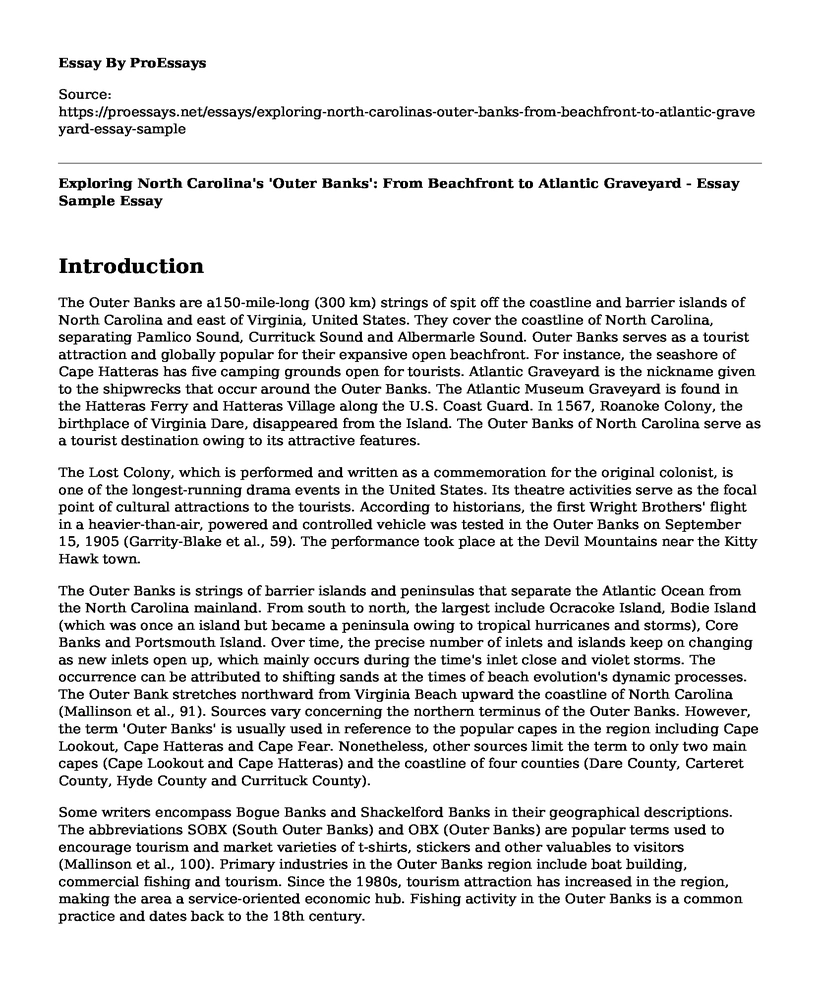Introduction
The Outer Banks are a150-mile-long (300 km) strings of spit off the coastline and barrier islands of North Carolina and east of Virginia, United States. They cover the coastline of North Carolina, separating Pamlico Sound, Currituck Sound and Albermarle Sound. Outer Banks serves as a tourist attraction and globally popular for their expansive open beachfront. For instance, the seashore of Cape Hatteras has five camping grounds open for tourists. Atlantic Graveyard is the nickname given to the shipwrecks that occur around the Outer Banks. The Atlantic Museum Graveyard is found in the Hatteras Ferry and Hatteras Village along the U.S. Coast Guard. In 1567, Roanoke Colony, the birthplace of Virginia Dare, disappeared from the Island. The Outer Banks of North Carolina serve as a tourist destination owing to its attractive features.
The Lost Colony, which is performed and written as a commemoration for the original colonist, is one of the longest-running drama events in the United States. Its theatre activities serve as the focal point of cultural attractions to the tourists. According to historians, the first Wright Brothers' flight in a heavier-than-air, powered and controlled vehicle was tested in the Outer Banks on September 15, 1905 (Garrity-Blake et al., 59). The performance took place at the Devil Mountains near the Kitty Hawk town.
The Outer Banks is strings of barrier islands and peninsulas that separate the Atlantic Ocean from the North Carolina mainland. From south to north, the largest include Ocracoke Island, Bodie Island (which was once an island but became a peninsula owing to tropical hurricanes and storms), Core Banks and Portsmouth Island. Over time, the precise number of inlets and islands keep on changing as new inlets open up, which mainly occurs during the time's inlet close and violet storms. The occurrence can be attributed to shifting sands at the times of beach evolution's dynamic processes. The Outer Bank stretches northward from Virginia Beach upward the coastline of North Carolina (Mallinson et al., 91). Sources vary concerning the northern terminus of the Outer Banks. However, the term 'Outer Banks' is usually used in reference to the popular capes in the region including Cape Lookout, Cape Hatteras and Cape Fear. Nonetheless, other sources limit the term to only two main capes (Cape Lookout and Cape Hatteras) and the coastline of four counties (Dare County, Carteret County, Hyde County and Currituck County).
Some writers encompass Bogue Banks and Shackelford Banks in their geographical descriptions. The abbreviations SOBX (South Outer Banks) and OBX (Outer Banks) are popular terms used to encourage tourism and market varieties of t-shirts, stickers and other valuables to visitors (Mallinson et al., 100). Primary industries in the Outer Banks region include boat building, commercial fishing and tourism. Since the 1980s, tourism attraction has increased in the region, making the area a service-oriented economic hub. Fishing activity in the Outer Banks is a common practice and dates back to the 18th century.
Beginning in the 19th century, commercial fishing was commenced in the region mainly due to the establishment of the Chesapeake and Albemarle Canal, which helped to simplify and ease shipping techniques for fishers. Saltwater fishing is the main cash crop of the region and has blossomed to become a popular tourist attraction. Tourists usually flock the area to take part in fishing activities (Jessica et al., 10). Wreckers are the Outer Banks' residents and make their living through scavenging damaged ships. The Outer Banks is home to feral horses' herds known as 'banker ponies'.
Work Cited
Garrity-Blake, Barbara, and Karen Willis Amspacher. Living at the Water's Edge: A Heritage Guide to the Outer Banks Byway. UNC Press Books, 2017.
Mallinson, David, et al. "Barrier Island and estuary co-evolution in response to Holocene climate and sea-level change: Pamlico Sound and the Outer Banks Barrier Islands, North Carolina, USA." Barrier Dynamics and Response to Changing Climate. Springer, Cham, 2018. 91-120.
Stocking, Jessica J., et al. "Managing native predators: Evidence from partial removal of raccoons (Procyon lotor) on the Outer Banks of North Carolina, USA." Waterbirds 40.sp1 (2017): 10-18.
Cite this page
Exploring North Carolina's 'Outer Banks': From Beachfront to Atlantic Graveyard - Essay Sample. (2023, Apr 07). Retrieved from https://proessays.net/essays/exploring-north-carolinas-outer-banks-from-beachfront-to-atlantic-graveyard-essay-sample
If you are the original author of this essay and no longer wish to have it published on the ProEssays website, please click below to request its removal:
- Paramedic Retrospective Analysis
- Effects of Ionizing Radiation on Deoxyribonucleic Acid (DNA)
- Essay Sample on Atrioventricular and Semilunar Valves
- Research Paper on Critical Habitat for the Candy Darter
- Paper Example on Investigating PDGFA-Driven Gliomagenesis: Impact on Malignant Glioblastomas
- Essay Example on Altering Genomes: A Practice Since Generations
- The Unconditional Love of My Pet Dog: A Bond That Lasts Forever - Essay Sample







